HOME GUARD MEMORIES AND INFORMATION - WARWICKSHIRE, BIRMINGHAM
24th WARWICKSHIRE (B'HAM) BATTN.
and
Pte. GEORGE BELCHER
This is a page within the
www.staffshomeguard.co.uk website.
To see full contents, go to
SITE MAP.
|
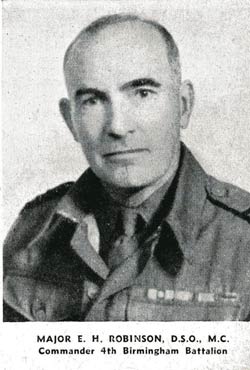
The
24th Warwickshire (Birmingham) Battalion
was commanded in the earlier part of
the war by
Lt.-Col. E.H. Robinson D.S.O., M.C. (1890-1968,
left).
Col. Robinson was Headmaster of
Moseley Grammar School
during this period. He had had a remarkable
Great War career in the
King's Shropshire Light Infantry,
being wounded twice and much decorated. There is further
information about him
elsewhere in this website. (That page also
contains images of 24th Battalion officers).
Later in the war the Battalion C.O. was Lt.-Col.
H. H. Little, M.C.
The 24th Battalion had evolved rapidly
in the autumn of 1940 from one of the
ten original Birmingham Home Guard battalions,
the
4th Birmingham Battalion
which had been commanded by Col. Robinson.
This was split up into more manageable units
as volunteers continued to increase in
numbers: the 24th was one of them and there
was at least one other.
The precise
territory for which this Battalion was
responsible has yet to be established but it
seems to have covered parts of
Moseley,
Sparkhill
and Sparkbrook.
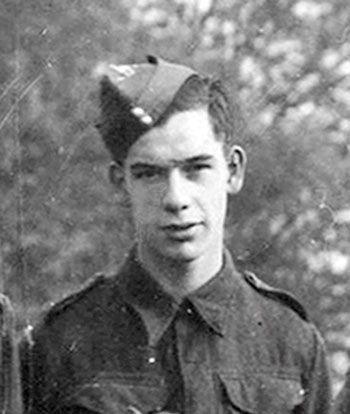
A
member of the Battalion was a young man named
George Samuel
Belcher
(b. 1924, right)
who lived with his parents at
76 Hillfield Road,
Sparkhill. George, pictured right
in 1943/4, probably joined the Home Guard when
he was 17 or 18, in 1941 or 1942, either as a
volunteer or a conscript. He was not liable
for call-up, whatever his personal feelings on
the matter may have been, as he was a
toolmaker and therefore in a reserved
occupation. He would still have been
serving his apprenticeship during his Home
Guard service. This must have been at
one of the local engineering factories,
possibly BSA,
not far from his home in Sparkhill.
Little documentation or memories involving
George's Home Guard service survive. What is
still available to us, however, is a couple of
group photographs, in both of which George
appears.
The first of these is a
panoramic image of George's unit, "B" Company
of the 24th Warwickshire (Birmingham)
Battalion. Of unknown date - but probably from
the later part of the war and possibly even a
image from the weeks leading up to stand-down
in December 1944; and at an unknown location
within the Battalion's area of responsibility.
George is standing in the back row, second
from the right. No other names have so far
been identified.

Click on the
image for a magnified version
The original of this photograph is of very
high quality and a much magnified version of
the above is available on an associated page
of this website. Click on the image to
view it.
The second image shows a similar
group, again with George in virtually the same
position within it.
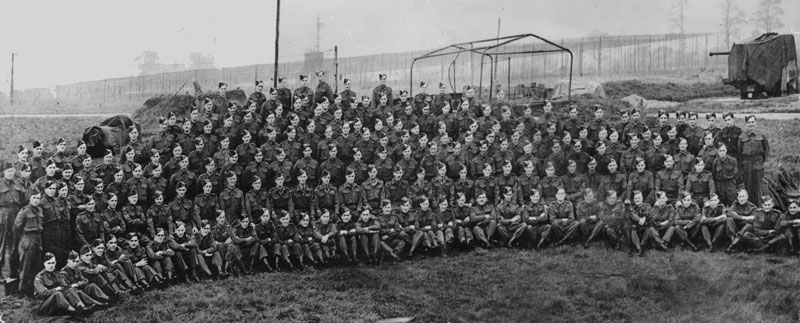
Click on the
image for a magnified version
Again, the magnified version is worthy of
closer inspection.
The men are all lined up ready for one of the
traditional panoramic photographs but, rather
than looking at the official cameraman
(wherever he is), they are gazing up at a
camera pointing at them from an adjacent
raised bit of land.
The large gun in
the background, perhaps of 3.7" or 4.5"
calibre, gives us a clue about the site. Also in the background is not
evidence of hop growing within the Birmingham
boundary; but rather the structure of a gun
laying radar installation (for the tracking of
Luftwaffe bombers - please see the note below). Clearly we are on
the edge of an anti-aircraft battery.
Somewhere, perhaps to the right, is more
significant artillery than the single gun - or
perhaps a Z-rocket battery. The precise
location is yet to be identified but it is
somewhere in the southern part of the city, or
even a little beyond the city boundary,
defending the southern approaches.
A NOTE ON
THE Mk II GROUND LAYING RADAR
It had been
established that the best way to get
accurate readings of aircraft
direction and altitude was to ensure
that the area surrounding the
detection equipment was flat. To
achieve that, huge (130 yard diameter)
octagonal ground mats were created
covering an area of about 15,000
square yards; these were of 2" mesh
(chicken wire), they consumed 230
rolls of material (each 4' x 50 yards)
and 650 miles of wire and they were
elevated some feet from the ground by
means of poles. They took a team of 50
men about four weeks to construct.
There was transmitting equipment on
the edge of the mat and a receiver
stuck right in the middle of it. You
can just see one of the latter in the
middle of the photograph background.
There were hundreds of these at
anti-aircraft batteries around the
country. The technology was superseded
before the end of the war but existing
set-ups were kept in operation. Whilst
the move of some Home Guards in
1942/43 from normal infantry duties to
the manning of A-A batteries was
usually to the newer "Z" rocket
batteries, many men also manned more
conventional batteries, including both
heavy and light guns. This site is
likely to have been one of them. |
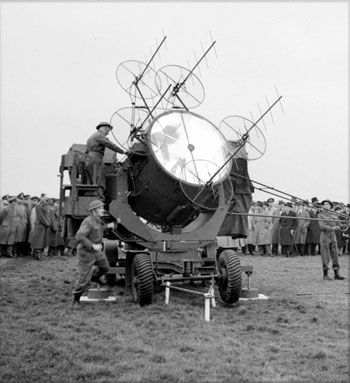
Other
documentation concerning George Belcher's Home
Guard service seems not to have survived. The
one memory of the latter within his family is
that he manned a searchlight
(perhaps like
this one, complete with its radar detection
equipment, shown in an official War Office
photograph, left). Whether
this was a one-off experience, or part of his
regular duties, is not known.
Home
Guards were certainly involved in this type of
activity. The vast majority of men who were
transferred from General Service duties in
1942/3 moved to anti-aircraft batteries,
either Heavy Anti-Aircraft with traditional
artillery, or, more likely, to the new
Z-rocket batteries. Perhaps searchlight duties
were part of a unit's a-a involvement, perhaps
they were entirely separate. Either way, the
searchlight battery would have been located a
distance away from the a-a battery or
batteries to which it was operationally
linked.
As for every Home Guard, George
would have seen a winding-down of the service
during the autumn of 1944 and then, on Sunday
December 3rd, a parade to mark the final
stand-down.
Peace was on the
horizon and, for young men like George, life beckoned.
|
|
GEORGE BELCHER'S LATER LIFE AND CAREER |
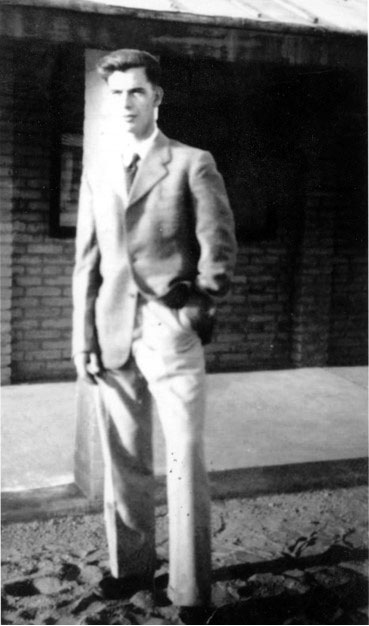 At
some stage George completed his apprenticeship
and became a fully skilled toolmaker,
presumably with the same employer. On 15th
July 1946 we see him joining the RAF. Perhaps
he volunteered as a Regular or, more likely,
it was the time of his call-up for National
Service after a period of deferral. At
some stage George completed his apprenticeship
and became a fully skilled toolmaker,
presumably with the same employer. On 15th
July 1946 we see him joining the RAF. Perhaps
he volunteered as a Regular or, more likely,
it was the time of his call-up for National
Service after a period of deferral.
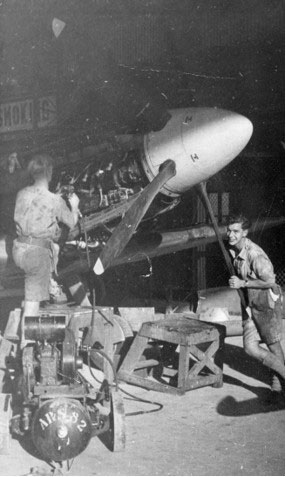 He
was posted to Egypt in the late 1940s and is
seen here (left) at that time. Whilst
there he contracted typhoid fever and was
cared for and brought back to health by a
nurse, Annie Adams, whom, following their
return to the U.K., he married in 1951 and
with whom he had three children. He
was posted to Egypt in the late 1940s and is
seen here (left) at that time. Whilst
there he contracted typhoid fever and was
cared for and brought back to health by a
nurse, Annie Adams, whom, following their
return to the U.K., he married in 1951 and
with whom he had three children.
George
had a very successful career in the RAF. His
rank for the first two or three years was the
normal one for a National Serviceman - AC2 and
LAC - and his trade was Airframe Fitter. He
is seen here, in those early days in Egypt,
working on an aircraft, probably a later
marque of Spitfire. Things changed in December
1949 after three-and-a-half years of service -
he had clearly decided by then that a career
in the RAF was for him - and a significant
promotion to Chief Technician occurred in that
month. The years of loyal service which
followed included further promotion to Warrant
Officer and we see him here receiving his
warrant at a ceremony at RAF Binbrook in the
1970s.
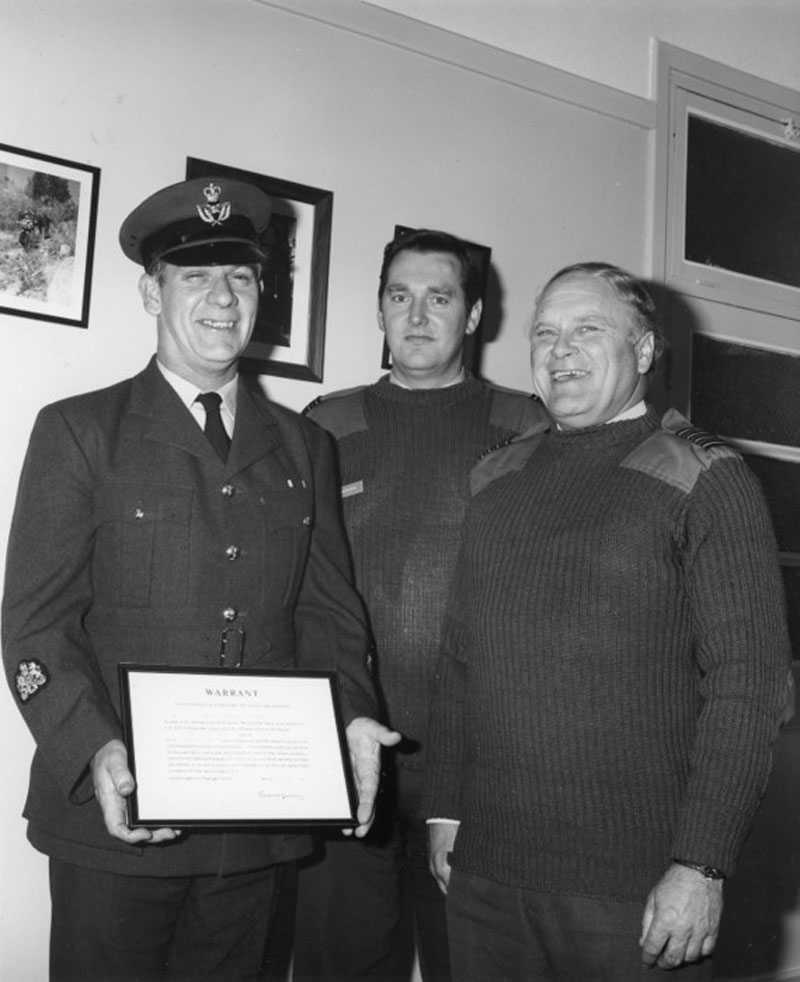
Warrant Officer George Belcher (formerly
Pte. G. S.
Belcher, Home Guard) eventually retired
from the RAF in August 1979 having completed
33 years of service.
|
Acknowledgements
We make grateful
acknowledgement to Andrew Belcher for providing
information and images and for generously
permitting their publication in this website; and
to other sources including members of the
Birmingham History Forum
Images ©
Andrew Belcher 2021
**********
IN
MEMORY OF
The Life and Service
of
and
of
All
his comrades in the
24th
Warwickshire (Birmingham)
Battalion Home Guard
|
|
x177A - August 2021


|